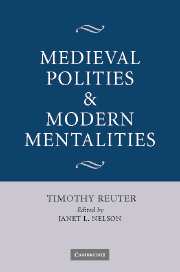Book contents
- Frontmatter
- Contents
- Editor's note
- Acknowledgements
- List of abbreviations
- Editor's introduction
- PART I MODERN MENTALITIES: HISTORIOGRAPHIES, METHODOLOGIES, PRECONCEPTIONS
- PART II THE SYMBOLIC LANGUAGE OF MEDIEVAL POLITICAL ACTION
- PART III POLITICAL STRUCTURES AND INTENTIONS
- 11 Assembly politics in western Europe from the eighth century to the twelfth
- 12 Sex, lies and oath-helpers: the trial of Queen Uota
- 13 Plunder and tribute in the Carolingian empire
- 14 The end of Carolingian military expansion
- 15 The Ottonians and Carolingian tradition
- 16 The making of England and Germany, 850–1050: points of comparison and difference
- 17 King, nobles, others: ‘base’ and ‘superstructure’ in the Ottonian period
- 18 The ‘imperial church system’ of the Ottonian and Salian rulers: a reconsideration
- 19 Peace-breaking, feud, rebellion, resistance: violence and peace in the politics of the Salian era
- 20 The medieval German Sonderweg? The empire and its rulers in the high Middle Ages
- 21 Mandate, privilege, court judgement: techniques of rulership in the age of Frederick Barbarossa
- 22 All quiet except on the Western Front? The emergence of pre-modern forms of statehood in the central Middle Ages
- Index
- References
11 - Assembly politics in western Europe from the eighth century to the twelfth
Published online by Cambridge University Press: 12 August 2009
- Frontmatter
- Contents
- Editor's note
- Acknowledgements
- List of abbreviations
- Editor's introduction
- PART I MODERN MENTALITIES: HISTORIOGRAPHIES, METHODOLOGIES, PRECONCEPTIONS
- PART II THE SYMBOLIC LANGUAGE OF MEDIEVAL POLITICAL ACTION
- PART III POLITICAL STRUCTURES AND INTENTIONS
- 11 Assembly politics in western Europe from the eighth century to the twelfth
- 12 Sex, lies and oath-helpers: the trial of Queen Uota
- 13 Plunder and tribute in the Carolingian empire
- 14 The end of Carolingian military expansion
- 15 The Ottonians and Carolingian tradition
- 16 The making of England and Germany, 850–1050: points of comparison and difference
- 17 King, nobles, others: ‘base’ and ‘superstructure’ in the Ottonian period
- 18 The ‘imperial church system’ of the Ottonian and Salian rulers: a reconsideration
- 19 Peace-breaking, feud, rebellion, resistance: violence and peace in the politics of the Salian era
- 20 The medieval German Sonderweg? The empire and its rulers in the high Middle Ages
- 21 Mandate, privilege, court judgement: techniques of rulership in the age of Frederick Barbarossa
- 22 All quiet except on the Western Front? The emergence of pre-modern forms of statehood in the central Middle Ages
- Index
- References
Summary
The phrase ‘assembly politics’ in the title is deliberately ambiguous: it refers both to politics conducted through assemblies and to politics conducted at assemblies. To address this apparently narrow theme is in fact to address a much wider problem: as we shall see, it was mainly at assemblies that early and high medieval polities were able to act and indeed to exist. ‘Polities’ and ‘politics’ are here merely neutral signifiers for past human activities to which we would probably apply similar terms in our own societies; their use does not imply that prominent lay and ecclesiastical personages in this period conceived of any of their activities as ‘politics’ or of the regna within which they operated as ‘polities’. Indeed, to make that point is precisely to raise the issue of how we are to avoid anachronism in dealing with our remote pasts. The principal approaches on offer duck this difficulty. We can write conventional political history for this period by casting it as accounts of the strategies and tactics pursued by the principal actors in their attempts to acquire and retain and enhance their power and of the ways in which these attempts conflicted with each other. But if we do this we shall smooth out the lumpiness of the past. Conventional political history presents rulers and ruled as engaged continuously in political activity and calculation: our sources may not so present them, but the narrative strategies implicit in such writing will reframe the past to make it look like this, just as actors in a film – unless it is very experimental indeed – are assumed to be and implied as being engaged in action even when they are off camera.
- Type
- Chapter
- Information
- Medieval Polities and Modern Mentalities , pp. 193 - 216Publisher: Cambridge University PressPrint publication year: 2006
References
- 7
- Cited by



